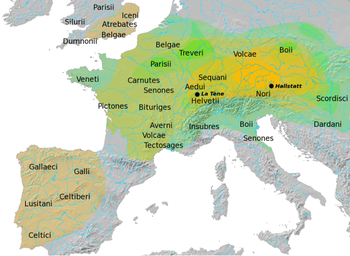
Back Boyos AN Boier BAR Бои (народност) Bulgarian Boied Breton Bois (poble celta) Catalan Bójové Czech Boii Welsh Boier German Βόιοι Greek Boyos Spanish

The Boii (Latin plural, singular Boius; Ancient Greek: Βόιοι) were a Celtic tribe of the later Iron Age, attested at various times in Cisalpine Gaul (present-day Northern Italy), Pannonia (present-day Austria and Hungary), present-day Bavaria, in and around present-day Bohemia (after whom the region is named in most languages; comprising the bulk of today's Czech Republic), parts of present-day Slovakia and Poland, and Gallia Narbonensis (located in modern Languedoc and Provence).
In addition, the archaeological evidence indicates that in the 2nd century BC Celts expanded from Bohemia through the Kłodzko Valley into Silesia, now part of Poland and the Czech Republic.[1]
They first appear in history in connection with the Gallic invasion of northern Italy, 390 BC,[2] when they made the Etruscan city of Felsina their new capital, Bononia (Bologna).[3]
After a series of wars they were decisively beaten by the Romans in the Battle of Mutina (193 BC) and their territory became part of the Roman province of Cisalpine Gaul. According to Strabo, writing two centuries after the events, rather than being destroyed by the Romans like their Celtic neighbours,
The Boii were merely driven out of the regions they occupied; and after migrating to the regions round about the Ister, lived with the Taurisci, and carried on war against the Daci until they perished, tribe and all—and thus they left their country, which was a part of Illyria, to their neighbours as a pasture-ground for sheep.[4]
Around 60 BC, a group of Boii joined the Helvetiis' ill-fated attempt to conquer land in western Gaul and were defeated by Julius Caesar, along with their allies, in the Battle of Bibracte.
Caesar settled the remnants of that group in Gorgobina, from where they sent 2,000 warriors to Vercingetorix's aid at the Battle of Alesia six years later. The eastern Boii on the Danube were incorporated into the Roman Empire in 8 AD.
- ^ Rankin 1996, p. 16
- ^ Smith, William, LLD (Ed.) (1854). Dictionary of Greek and Roman Geography. Entry: "ETRU´RIA". Retrieved 4 November 2023.
{{cite book}}: CS1 maint: location missing publisher (link) CS1 maint: multiple names: authors list (link) - ^ "Felsina | Italy, History, Map, & Facts | Britannica". www.britannica.com. 13 October 2023. Retrieved 4 November 2023.
- ^ Strabo, 5.213.
© MMXXIII Rich X Search. We shall prevail. All rights reserved. Rich X Search